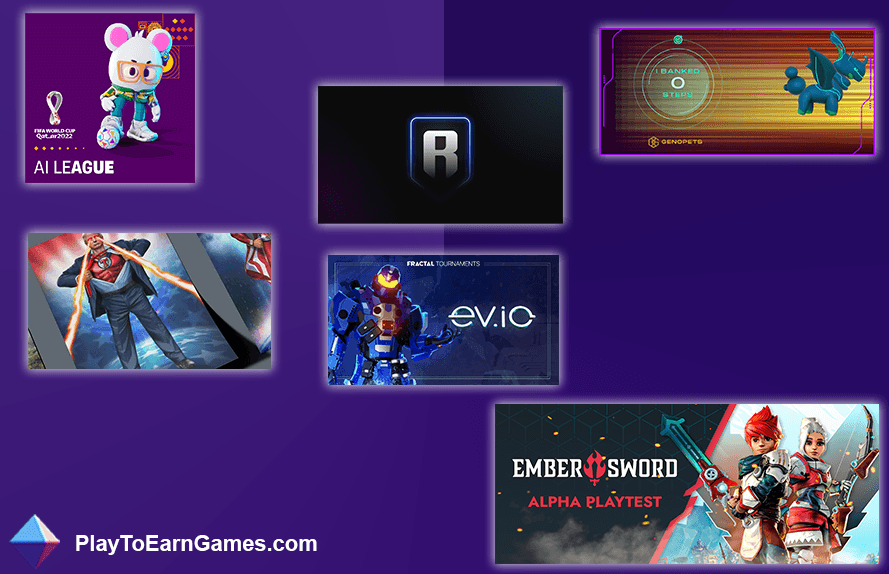
Crypto Vs NFT: Crypto and NFT are both digital assets, but they serve different purposes. Crypto refers to cryptocurrencies used for financial transactions, while NFTs are unique digital tokens representing ownership of specific assets, such as art or collectibles.
Cryptocurrencies, like Bitcoin and Ethereum, are used as digital currencies for online transactions and investments. On the other hand, NFTs are unique tokens that represent ownership of specific digital assets and are bought and sold on blockchain platforms. Understanding the differences between crypto and NFTs is crucial for anyone looking to invest or participate in the digital asset market.
Table of Contents
We’ll explore the distinctions between these two types of digital assets, their uses, and the potential implications for investors and creators.

Credit: playtoearngames.com
The World Of Cryptocurrency
Cryptocurrency has been a buzzword in the financial world, revolutionizing how we perceive and use money. The emergence of digital currencies such as Bitcoin and Ethereum has sparked a global phenomenon, challenging traditional financial systems and introducing innovative methods of conducting transactions.
What Is Cryptocurrency?
Cryptocurrency is a digital or virtual form of currency that uses cryptography for security and operates independently of a central authority, such as a government or bank. It is decentralized, leveraging blockchain technology to facilitate secure and transparent transactions.
Understanding Crypto’s Value
- Cryptocurrency derives its value from supply and demand dynamics, much like traditional commodities.
- The scarcity of certain cryptocurrencies, such as Bitcoin, contributes to their perceived value.
- Investor sentiment and market speculation also play a significant role in shaping the value of cryptocurrencies.
Crypto Vs Traditional Currency
When comparing cryptocurrency to traditional currency, there are several distinguishing factors that set them apart:
- Cryptocurrency transactions are typically faster and more secure due to blockchain technology.
- Traditional currency is centralized and regulated by governments, while cryptocurrency operates in a decentralized, peer-to-peer network.
- Cryptocurrency allows for greater global accessibility and inclusivity, transcending geographical and political boundaries.
- Traditional currency is prone to inflation and government manipulation, whereas cryptocurrencies are designed to be deflationary and immune to external influence.

Credit: www.forbes.com
The Rise Of Non-fungible Tokens (nfts)
The world of cryptocurrency has been buzzing with the emergence of a new phenomenon known as Non-Fungible Tokens or NFTs. This revolutionary innovation has been generating a great deal of interest and excitement in the digital world, offering a unique way to buy, sell, and own digital assets. In this blog post, we will delve into the rise of Non-Fungible Tokens, exploring what they are, their unique qualities, and how they compare to traditional assets.
What Are Nfts?
Non-Fungible Tokens (NFTs) are a type of digital asset that represents ownership or proof of authenticity of a unique item or piece of content using blockchain technology. Unlike cryptocurrencies such as Bitcoin or Ethereum, which are interchangeable and have the same value, NFTs are non-fungible, meaning each token is distinct and cannot be replicated or replaced.
Exploring The Uniqueness Of Nfts
NFTs are prized for their irreplaceable nature, as each token is one of a kind, representing digital artwork, collectibles, virtual real estate, and more. The uniqueness of NFTs lies in their ability to create verifiable scarcity and ownership in the digital realm, allowing creators and collectors to monetize and trade digital assets like never before.
Nfts Vs Traditional Assets
When comparing NFTs to traditional assets, it’s clear that NFTs offer a fundamentally new way to buy, sell, and trade digital items. Traditional assets such as stocks, bonds, and real estate are tangible and have a physical presence, whereas NFTs exist purely in the digital space, leveraging blockchain technology to provide indisputable proof of ownership and authenticity.
Comparing Crypto And Nfts
Cryptocurrencies and Non-fungible Tokens (NFTs) have gained significant attention and popularity in the digital world. While both fall under the umbrella of blockchain technology, they serve different purposes and have distinct characteristics. In this article, we will explore the key differences between cryptocurrency and NFTs, highlighting their unique features and examining the relationship between these two fascinating digital assets.
Differentiating Features Of Cryptocurrency
Cryptocurrencies, such as Bitcoin and Ethereum, are digital or virtual forms of currency that utilize cryptography to secure transactions and control the creation of new units. Here are some key characteristics that set cryptocurrencies apart:
- Decentralization: Cryptocurrencies operate on decentralized networks, meaning there is no central authority governing their transactions. Instead, transactions are verified and recorded by a network of computers known as nodes.
- Blockchain Technology: Cryptocurrencies rely on blockchain technology, which is a distributed ledger that securely records transactions across multiple computers. This transparent and tamper-proof system ensures the integrity and trustworthiness of the cryptocurrency network.
- Fungibility: Cryptocurrencies are fungible, meaning that each unit is interchangeable with another. For example, one bitcoin is equivalent to another bitcoin, making them mutually replaceable.
- Global Accessibility: Cryptocurrencies enable borderless transactions, allowing users to send and receive funds across the globe without involving traditional financial intermediaries.
Key Characteristics Of Nfts
NFTs, on the other hand, are unique digital assets that represent ownership or proof of authenticity for a specific item or piece of content. Here are some key characteristics of NFTs:
- Non-Fungibility: Unlike cryptocurrencies, NFTs are non-fungible, meaning each token is unique and cannot be exchanged on a like-for-like basis. Each NFT has a distinct value and identity.
- Ownership and Authenticity: NFTs provide proof of ownership and authenticity for digital assets, including artwork, music, videos, and virtual real estate. This makes it possible for creators to monetize their work in a secure and transparent manner.
- Scarcity and Rarity: NFTs can be minted in limited quantities, making certain items exclusive and rare. This scarcity adds value and desirability to NFTs.
- Interoperability: NFTs can be bought, sold, and traded on various platforms and marketplaces, allowing for easy interaction and transferability among collectors and enthusiasts.
Interactions Between Crypto And Nfts
Given that both cryptocurrencies and NFTs are built on blockchain technology, there are natural interactions between the two:
- Crypto as Payment: Cryptocurrencies serve as a popular method of payment for NFT transactions, providing a seamless and efficient way to exchange value for unique digital assets.
- Investment and Speculation: Both cryptocurrencies and NFTs have attracted investors and speculators seeking potential returns. Some enthusiasts view NFTs as a new form of digital collectibles.
- Smart Contracts: Smart contracts, which are self-executing contracts with the terms of the agreement directly written into code, are used in both cryptocurrencies and NFTs to automate transactions and ensure trust among parties involved.
In conclusion, while cryptocurrencies and NFTs are distinct entities, they share underlying blockchain technology and offer unique benefits and opportunities in the digital realm. Understanding the differences and similarities between these two assets is crucial for navigating the evolving landscape of the digital economy.
The Power Words Of Crypto And Nfts
The world of cryptocurrency and non-fungible tokens (NFTs) has taken the digital space by storm. These two concepts have revolutionized how we perceive value and ownership in the digital realm. In this article, we will delve into the power words of crypto and NFTs, exploring the topics of decentralization, ownership and scarcity, as well as the unique applications and use cases of both.
Decentralization And The Crypto Revolution
In the world of cryptocurrency, decentralization is the buzzword. Unlike traditional financial systems, where banks and governments hold control, cryptocurrencies operate on decentralized networks called blockchain. This means that transactions are not controlled by a central authority but rather verified and recorded by a network of computers spread across the globe. The power of decentralization lies in its ability to remove intermediaries, enabling peer-to-peer transactions and creating a transparent and secure environment. Cryptocurrencies such as Bitcoin and Ethereum have disrupted the financial industry and opened up new possibilities for individuals to have control over their own money.
Ownership And Scarcity In The Nft World
On the other hand, non-fungible tokens (NFTs) have revolutionized the concept of ownership in the digital world. While cryptocurrencies like Bitcoin represent fungible assets, NFTs are unique and indivisible. Think of NFTs as digital collectibles, where each token represents a one-of-a-kind item or piece of art. NFTs have gained immense popularity in the art and gaming industries, allowing creators to monetize their digital creations and giving collectors the opportunity to own digital assets with provable scarcity. This concept of ownership, combined with the established provenance and authenticity of NFTs on the blockchain, opens up exciting possibilities for artists, collectors, and investors.
Unique Applications And Use Cases Of Both
The applications and use cases of both crypto and NFTs go beyond the realms of finance and art. Cryptocurrencies have facilitated cross-border transactions, remittances, and even decentralized finance (DeFi) platforms that offer financial services without intermediaries. NFTs, apart from the art industry, have found applications in real estate, virtual worlds, music, and even tokenized representations of physical assets. These use cases demonstrate the versatility and potential impact of both crypto and NFTs in various sectors, ushering in new modes of ownership, value exchange, and creative expression.
The Future: Crypto, Nfts, And Beyond
The world of digital assets is rapidly evolving, with cryptocurrencies and NFTs paving the way for a new era of possibilities. As we delve deeper into this exciting landscape, it becomes evident that the future holds even more potential for technological advancements and groundbreaking innovations. In this article, we will explore the trends and possibilities in the crypto space, the potential impact of NFTs on various industries, and the evolving technologies that lie beyond crypto and NFTs.
Trends And Possibilities In The Crypto Space
The crypto space is constantly evolving, with new trends and possibilities emerging regularly. From the inception of Bitcoin to the rise of altcoins, the world of cryptocurrencies has witnessed tremendous growth. It has not only sparked the interest of individual investors but has also garnered attention from institutions and governments worldwide.
One of the most significant trends in the crypto space is the integration of blockchain technology into various industries. This decentralized technology offers secure and transparent transactions, making it an ideal solution for sectors such as finance, supply chain management, and healthcare.
Furthermore, the concept of decentralized finance (DeFi) has gained immense popularity in recent years. DeFi platforms eliminate the need for intermediaries, allowing users to directly engage in financial activities like lending, borrowing, and trading. This opens up a realm of possibilities for individuals who previously faced barriers to accessing traditional financial services.
Potential Impact Of Nfts On Various Industries
NFTs, or non-fungible tokens, have taken the digital world by storm. These unique digital assets have the potential to revolutionize various industries, from art and gaming to real estate and beyond. Through NFTs, creators can tokenize their work, giving them the ability to sell and monetize their creations in ways never before possible.
In the art world, NFTs have disrupted the traditional model by enabling artists to sell digital artworks directly to collectors, bypassing the need for galleries or auction houses. Additionally, NFTs provide artists with ongoing royalties, ensuring they are compensated for their work even after the initial sale.
The gaming industry has also witnessed a significant impact from NFTs. Players can now own and trade in-game assets as NFTs, creating a thriving digital economy within games. This opens up new revenue streams for game developers and provides players with true ownership and value for their virtual possessions.
Evolving Technologies Beyond Crypto And Nfts
While cryptocurrencies and NFTs are pushing boundaries, there are several emerging technologies that show promise for the future. One such technology is Artificial Intelligence (AI), which has the potential to transform various industries and enhance efficiency.
Internet of Things (IoT) is another technology that is gaining traction. It connects everyday objects to the internet, enabling seamless communication and data transfer. This has implications for sectors such as smart homes, agriculture, and transportation.
Moreover, decentralized web technologies like IPFS (InterPlanetary File System) and blockchain-based domain names are revolutionizing internet infrastructure, making it more secure, resilient, and censorship-resistant.

Credit: playtoearngames.com
Frequently Asked Questions Of Crypto Vs Nft?
What Is The Difference Between Crypto And Nft?
Crypto refers to digital currencies like Bitcoin, while NFTs are digital assets representing ownership or proof of authenticity. While both use blockchain technology, crypto is a form of currency, while NFTs can represent anything unique, like art or collectibles.
How Do Crypto And Nfts Derive Their Value?
Cryptocurrencies derive their value from factors like supply and demand, as well as market speculation. On the other hand, the value of NFTs is determined by their uniqueness, scarcity, and the perceived value assigned by buyers and collectors.
Can You Convert Crypto To Nfts?
While crypto and NFTs are both based on blockchain technology, they serve different purposes and cannot be directly converted. However, NFTs can be purchased using cryptocurrencies, providing a bridge between the two ecosystems.
Conclusion
Overall, the debate between crypto and NFTs is ongoing, but both have their unique benefits and potential for growth. While cryptocurrencies offer decentralized currency and investment opportunities, NFTs provide a pathway for creators to monetize their digital assets. Understanding the distinctions and similarities between the two can empower individuals to explore new opportunities within the digital landscape.
Whether you choose crypto, NFTs, or both, staying informed and adapting to the ever-evolving world of digital assets can lead to exciting possibilities in the future.


